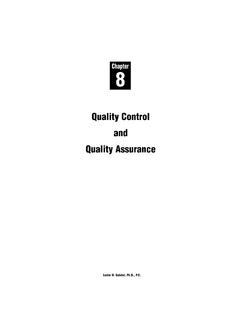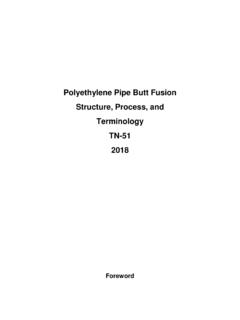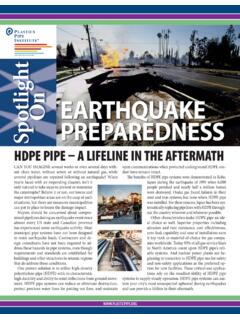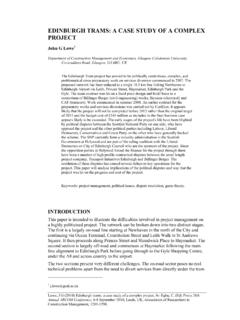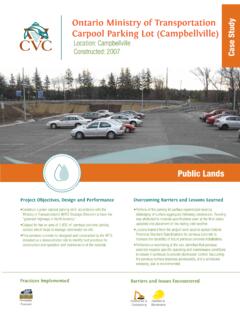Transcription of LARGE DIAMETER GAS DISTRIBUTION MAINS A North …
1 LARGE DIAMETER GAS DISTRIBUTION MAINS A North American case study of 18 (450mm) and 20 (500mm) DIAMETER Insert Renewal main Installations Karen S. Lively Technical Manager Performance Pipe division of Chevron Phillips Chemical Company LP ABSTRACT Over 97 percent of all of the new gas DISTRIBUTION piping installed each year is polyethylene pipe. However, the installation of larger DIAMETER polyethylene pipe gas pipe MAINS has not kept pace with the use of polyethylene in other industries. Using two case studies of 20 (500mm) DIAMETER and 18 (450mm) DIAMETER new installations, this presentation explores why polyethylene pipe was chosen for these applications. BACKGROUND Natural Gas was observed early in the history of the United States by Native Americans in the mountainous Appalachian region.
2 History also records that George Washington, the first president of the United States, noted burning gas springs during his travels in the 1700 s. But it wasn t until the 1820 s near Lake Erie in New York that William Aaron Hart, a gunsmith, bored a hole in the side of a burning creek to provide gas service through a lead pipe supplying local stores and buildings with fuel. After over 100 years of gas DISTRIBUTION service, there are over 63 million gas service connections and over 6 billion feet ( million km) of gas DISTRIBUTION MAINS in the United States. The first polyethylene gas DISTRIBUTION lines were installed in the 1950 s. Figure 1 shows documentation of a pipeline insert renewal installed in July of 1959. With over fifty years in service, polyethylene pipes have proven their reliability and durability.
3 Polyethylene pipes have become the material of choice for the United States Gas DISTRIBUTION market. Polyethylene alone represents over 39 million services and 3 billion feet (914,000 km) of the pipes in service1 ; and over 97 percent of all new gas DISTRIBUTION piping installed each year. 1 American Gas Association (AGA) 2006 inventory of gas DISTRIBUTION pipelines , Figure 1 Caney Kansas insert renewal Throughout the fifty years of service, polyethylene pipe resins and pipes have improved in both toughness and durability from the original pipelines that have already served our industry well. Despite this extensive history of using polyethylene pipe, roughly 10 percent by length of new polyethylene gas DISTRIBUTION MAINS are larger in DIAMETER than 6 IPS (168mm), and less than 5 percent by length are larger than 12 IPS (320mm).
4 Polyethylene pipe is generally found to be less expensive to install than protected steel MAINS . Pipeline Gas Journal s 43rd Annual Pipe Report based on survey of utility companies reported the following comparison costs for pipe MAINS . Average Cost per ft to Install Gas DISTRIBUTION Mains2 main Size Polyethylene Cost/ft Steel Cost/ft 2 inch IPS $ to $ $ to $ 4 inch IPS $ to $ $ to $ 6 inch IPS $ to $ $ to $ Many utility companies today are using or evaluating polyethylene pipes up through 12 inch DIAMETER (200mm) due to both the performance of polyethylene pipe and the cost savings through operations and installation. At the 2004 AGA Operations Conference Chris Amfer with Duke Energy documented the business case for selecting 12-inch polyethylene over steel pipe in a direct burial 2 Tubbs, 43rd Annual Pipe Report -- Gas Demand, Maintenance Projected to Drive DISTRIBUTION Spending , Pipeline Gas Journal, December 2008.
5 Twelve inch DIAMETER pipelines are now considered standard products. Pipelines larger than 12-inch have been installed and are operating successfully. 3 Amfer, Chris (Duke Energy) 12 inch PE pipes , AGA Operations Conference 2004, Phoenix, AZ Estimated Annual Installation of Gas DISTRIBUTION PE MAINS in feet2 inch through 6 inch6 inch through 12 inchGreater than 12 inchFigure 2 Installation by Size Range of PE pipe. This represents 97% of all gas pipe installed each year. One of the earliest installations occurred in 1989 where a 20 inch DIAMETER pipe sliplined into existing MAINS in the state of Colorado where LARGE DIAMETER pipe was slip-lined into an existing cast iron main to renew the Figure 3 Early LARGE DIAMETER main installation With lower installation costs, and a proven long term service life, the question remains as to why the use of larger DIAMETER polyethylene pipe MAINS has lagged the use in smaller diameters .
6 This is in marked contrast to other industries in the United States such as water, wastewater, mining, firewater, and many other industrial applications where polyethylene pipes are routinely installed up through 63inch DIAMETER (1600mm). Recent industrial projects using (2000mm) DIAMETER PE pipes have also been Figure 4 LARGE DIAMETER Industrial PE Pipe Applications Some of the discrepancy in sizes is attributable to the predominance of smaller DIAMETER DISTRIBUTION MAINS compared to the larger DISTRIBUTION MAINS . While the confidence in polyethylene pipe is very high, there may be a perception that there are logistical and operational obstacles to integrating LARGE DIAMETER polyethylene MAINS into gas DISTRIBUTION systems in full compliance with federal regulations. This paper 4 Pipeline & Gas Journal, December 1990 5 Bertinchamps, Belloir (Total Petrochemicals) and Blomster (Pipelife) Extension of the application field of PE100 pipes Plastic Pipes XIV, Budapest, Hungary 2008.
7 Will present a summary of current installations at two utilities and provide answers to some frequently asked questions. 18-INCH PIPE main INSTALLATIONS IN CHICAGO, ILLINOIS Peoples Gas, a subsidiary of Integrys Energy Group, serves 830,000 customers in the city of Chicago, Illinois. Peoples Gas first began serving the city of Chicago in 1850 when they were chartered to provide natural gas to light the city streetlights. Peoples Gas expanded their service to supplying gas for cooking in the 1920 s and were able to completely supply the city natural gas for heating in 1962 eliminating less clean heating methods, such as coal and Peoples Gas of Chicago has used polyethylene extensively throughout their operations. As a result the utility recognized the benefits of polyethylene pipe for its corrosion resistance, cost effectiveness, and ease of installation.
8 For Peoples the driving force to move to larger diameters was the need for a cost effective replacement of older cast iron pipelines. Peoples Gas DISTRIBUTION lines have an MAOP of 25psi, however many sections of the city are still serviced by low pressure MAINS (inches of H2O). By increasing the pressure, the existing cast iron lines can be insert-renewed with smaller DIAMETER polyethylene lines while maintaining the same flow rate and providing a leak free replacement pipe with minimal impact on the public. One of Peoples Gas 18-inch DIAMETER installations used sliplining to install high density polyethylene gas DISTRIBUTION main into an existing 30-inch DIAMETER cast iron main . The main operated in the center area of Chicago at very low pressures. Excavation to replace the pipe would have been significantly more costly as well as having a significant negative impact on Chicago s citizens.
9 Other applications where 6 Figure 5 18 inch PE pipe in Chicago, IL Peoples has used 18-inch DIAMETER pipe include slip-lining applications into 20-inch and 24-inch existing cast iron lines. Peoples Gas walks, or pushes the pipe into the existing line for their slipline applications. Their experience is that they have more control over the pipe and the project in the heavily congested areas using the pushing technique. The most current application in Chicago involves relining 5100 feet of a 24-inch cast iron line that is buried 5 feet deep in an area of heavy traffic in the city. The longest section to be pushed in is 1800 feet, and the pits are typically 40 to 60 feet long. Eighteen inch DIAMETER applications are quickly becoming routine for Peoples Gas in Chicago.
10 Figure 6 18 inch fusion at Peoples Gas, Chicago7 20-INCH (500MM) PIPE INSTALLATION IN KANSAS CITY, MISSOURI Missouri Gas Energy is a natural gas DISTRIBUTION company headquartered in Kansas City, Missouri that serves over a half-million customers in 155 western Missouri communities. Missouri Gas Energy is a division of Southern Union Company (SUG).8 After more than 60 years of service, it was time to retire the 19,000 feet of 24-inch cast iron pipe that carried natural gas through Kansas City, Missouri. Missouri Gas Energy has had a successful track record of using polyethylene pipe and knew that they wanted to replace the cast iron pipe with polyethylene. The line to be replaced ran underneath a major road to supply gas to an established residential neighborhood, so trenchless technology was desired to 7 Photograph courtesy of John Goetz of People Gas, an Integrys Company 8 minimize any impact on the community.
